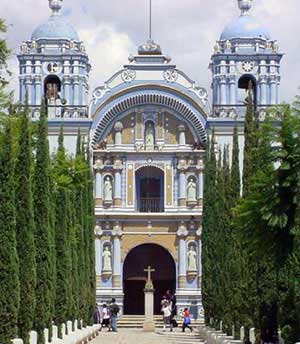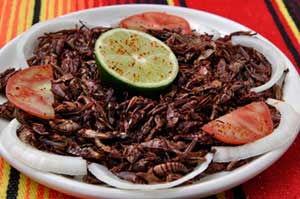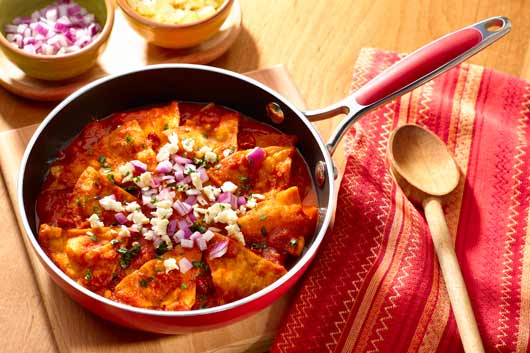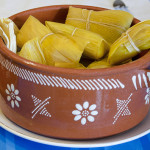
I arrive by bus just after sunset. A 6-hour drive southeast of Mexico City, Oaxaca is known for its archeological wonders, colonial-era architecture, and its unique and astonishingly complex cuisine.
At the heart of Oaxaca’s centro histórico is the zocalo, a Spanish-style open plaza not unlike many others in Mexico, only this one is brimming with thousands of poinsettias and other native plants and trees. The city expands from here and its picturesque streets are well-suited for the idle traveler with a lot of time and little or no agenda.
At night, the zocalo is dotted with food vendors selling a type of street corn, simply called elote, the Spanish word for corncob. The corn is grilled and sold either right on the cob slathered with mayonnaise, rolled in grated cheese, and sprinkled with chile powder and lime, or in a cup with the same toppings. I opt for the cob, hand over a couple of pesos, and a few seconds later, am handed back a hot piece of decorated corn on a stick.
Read Related: Oaxacan Street Corn (Elote)
 Elote, as I was about to discover, awakens every taste bud in your mouth. The starchy kernels have a mild sweetness but a remarkably rich and silky texture. The creamy mayo and salty cheese wonderfully enhances the charred flavor of the corn and the sweet spicy chiles set off fireworks in my mouth. The kernels are plump and juicy and so defiantly messy that I realize why people opt for their elote in a cup. I finish the corn hunched over the nearest garbage can and slowly wander back to my hotel.
Elote, as I was about to discover, awakens every taste bud in your mouth. The starchy kernels have a mild sweetness but a remarkably rich and silky texture. The creamy mayo and salty cheese wonderfully enhances the charred flavor of the corn and the sweet spicy chiles set off fireworks in my mouth. The kernels are plump and juicy and so defiantly messy that I realize why people opt for their elote in a cup. I finish the corn hunched over the nearest garbage can and slowly wander back to my hotel.
Early the next morning, I meet with Nora, a local cooking instructor who, through a mutual friend, has graciously agreed to be my guide for the day. “Hurry, we have to get to the market before it gets busy” she declares with a cook’s innate sense of urgency and timing. Ocotlán is some 20 miles south of Oaxaca and on Fridays, there’s a huge market spread out behind the town’s towering blue and gold Baroque church. Weaving through the market, I pass piles of fresh chiles, all kinds of spices, mounds of colorful breads and pastries, chocolate, meats, fruits, vegetables, and of course, corn in all shapes and colors.
We rest our feet at a small stall where the owner was a spitting image of Mexican artist Frida Khalo. Nora orders something in Spanish and “Frida” appears with 3 cups of hot, sticky, gooey soup and sits down with us. Offering me the first cup, Nora explains that the traditional Oaxacan food is passed down from the ancient Mexican civilizations, and many of those dishes remain unchanged to this day, like the atoles that we’re sipping. Atoles are a hot beverage made from grinding starchy white corn kernels and boiling them with water into a thick gruel. It can be sweetened with piloncillo (a type of Mexican brown sugar) and blended with chocolate or cinnamon. The unsweetened version tastes something like congee—a Chinese porridge made with rice and water—while the sweetened versions remind me more of a thick cooked-down cream of wheat.
After the market and a visit with one of Nora’s friends in Ocotlán, we stop for a late lunch at a restaurant in San Martin Tilcajete, a town renowned for its artisans who painstakingly carve and paint small wooden animals. It is the only restaurant in town, in fact, and we appear to be the only customers. It is here that I first try chapulines (Oaxaca’s infamous fried grasshoppers) and gusanos de maguey (edible worms that live in the agave plant). No stranger to these dishes, Nora tells me that as unpalatable as they may seem to foreigners, these insects are really just extensions of eating the plants themselves, since they live and feed within those plants.
 Somehow this argument makes the concept of eating bugs a little easier to swallow. The pleasant crunchiness of the grasshoppers gives way to a grassy flavor with a salty kick. I sprinkle them on top of a plate-size tortilla called a tlayuda smeared with a mole paste. The maguey worms were roasted and ground then mixed into a chile-lime powder, which gave the spice blend a heightened intensity and complexity. We sprinkle this on just about everything. A shot of good mezcal helps to wash it all down.
Somehow this argument makes the concept of eating bugs a little easier to swallow. The pleasant crunchiness of the grasshoppers gives way to a grassy flavor with a salty kick. I sprinkle them on top of a plate-size tortilla called a tlayuda smeared with a mole paste. The maguey worms were roasted and ground then mixed into a chile-lime powder, which gave the spice blend a heightened intensity and complexity. We sprinkle this on just about everything. A shot of good mezcal helps to wash it all down.
I spend the next few days exploring the city by foot. I marvel at the elaborately carved ceilings of the Templo de Santo Domingo, sit down for a comida corrida at the bustling 20 de Noviembre market, stroll among centuries-old ferns, trees, and cacti at the Jardin Etnobotanico, visit the ancient palaces and tombs of Monte Alban, and hunt for treasures at small handicraft markets throughout the city. And when I feel tired from walking, I find a café and order Oaxaca’s legendary hot chocolate and some warm, crusty bread.
On my last day, I wake up early to savor my few remaining hours in Oaxaca. I walk over to the Plazuela Labastida, a small plaza that dips a few feet below street level like a shallow swimming pool. Umbrellas, tarps, and tents cover the plaza—a makeshift roof for the handicraft market that occupies the space. El Topil restaurant is practically hidden behind the market on this sunken street. It’s a neighborhood restaurant that looks as though it has been handed down a generation or two. A sturdy woman in her fifties in a dress and floral apron greets me with a shout from the open kitchen. She is clearly the waitress/chef/owner of this establishment and I am her first customer.
 I order, and several minutes later she brings over my enchiladas with black mole sauce. More than just a chocolate sauce, black mole or mole negro is one of the true wonders of Oaxacan food. It can have over 20 ingredients including a variety of chiles, almonds, raisins, herbs, spices—and yes, freshly ground chocolate. All told, it can take as long as two days to prepare but the result is a stunning, richly aromatic, earthy brown sauce that defies explanation.
I order, and several minutes later she brings over my enchiladas with black mole sauce. More than just a chocolate sauce, black mole or mole negro is one of the true wonders of Oaxacan food. It can have over 20 ingredients including a variety of chiles, almonds, raisins, herbs, spices—and yes, freshly ground chocolate. All told, it can take as long as two days to prepare but the result is a stunning, richly aromatic, earthy brown sauce that defies explanation.
The enchiladas are superb. I mop up every bit of sauce with some extra tortillas. As I approach the kitchen to pay my bill, I noticed the scent of banana leaves in the air. “Tamales?” I ask. She nods, pointing to the tiny green packages neatly resting in a couple of steamers. “I’ll take one of each please…to go.”
That was my last meal in Oaxaca, a fitting end to a culinary trip that exceeded all expectations. Returning home to New York, the realities of traveling begin to set in. I shuffle from taxi to airport to plane then vice versa before finally landing at my doorstep. As I unpack, I find the tamales uneaten in my bag. They are cold and deflated, but the aroma of the banana leaves and the corn masa are unmistakable. I eat them anyway, hungry for the next great adventure.











